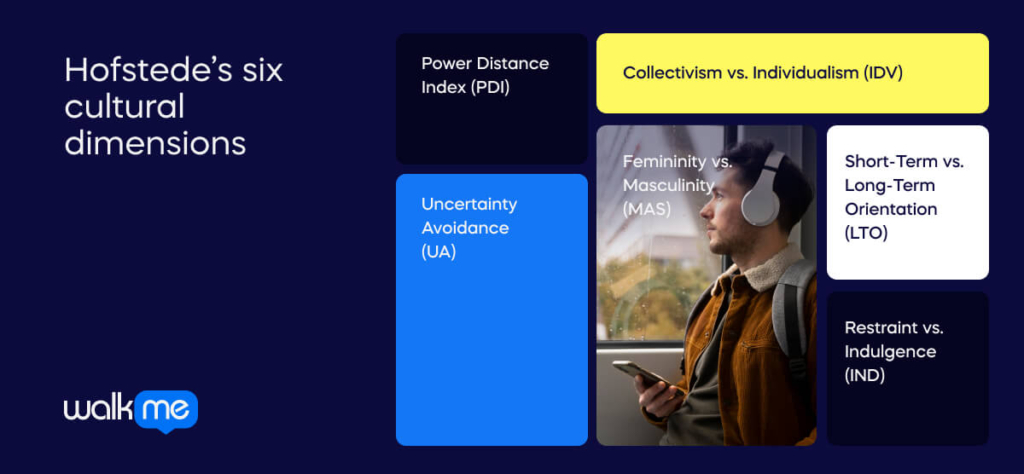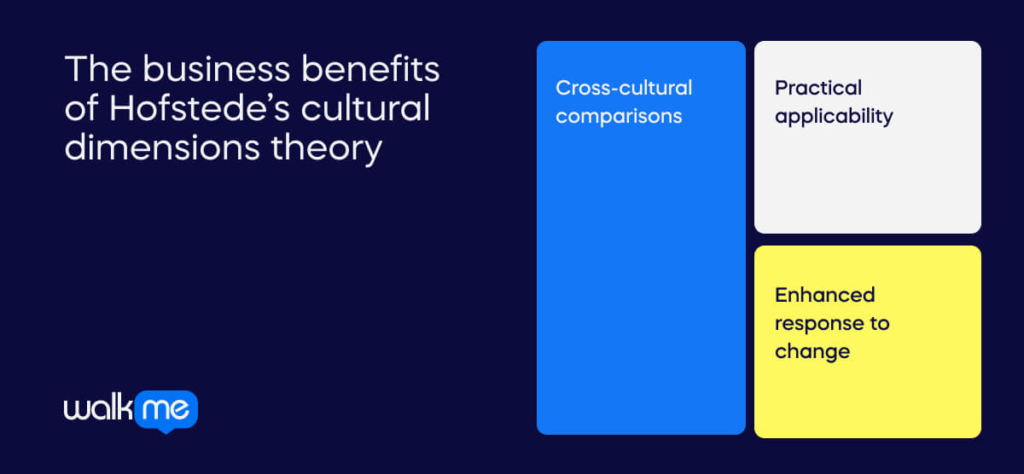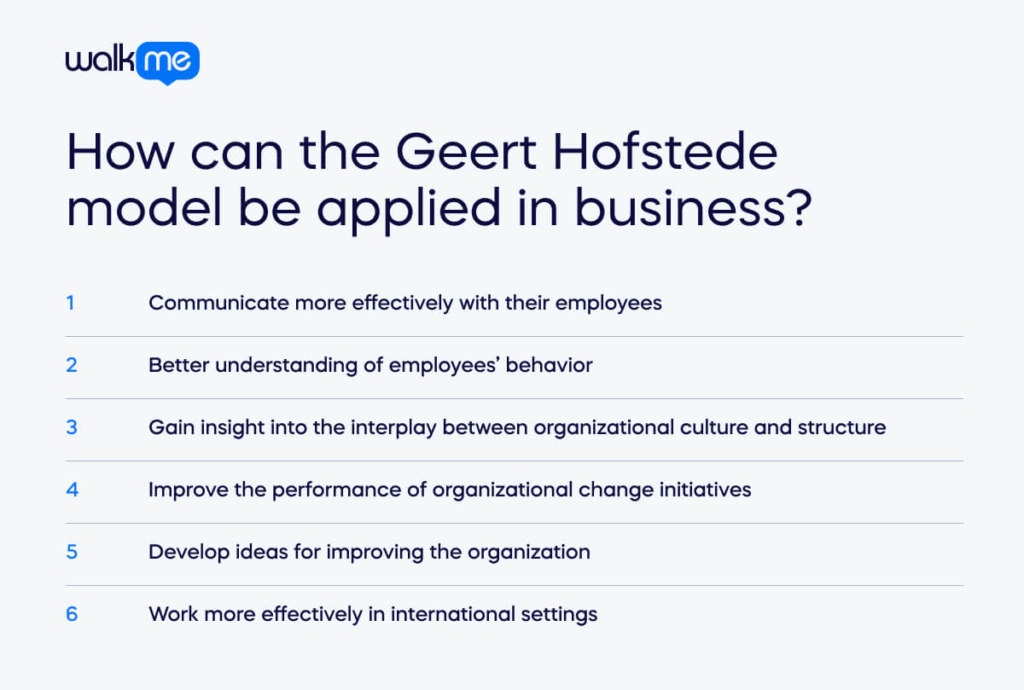Geert Hostede’s cultural dimensions of national cultures is a change management model widely used in organizations to identify and understand cultural differences worldwide.
The six cultural dimensions are the power distance index (PDI), individualism vs. collectivism (IDV), masculinity versus femininity (MAS), uncertainty avoidance index (UAI), long-term orientation versus short-term normative orientation (LTO), and indulgence versus restraint (IVR).
Since the 1980s, the Geert Hofstede model has been a valuable tool for understanding how culture affects business. It is useful for several business areas, including recruitment, training, conflict resolution, and change management.
This post will cover some basics to give you a taste of what Hofstede’s cultural dimensions theory is – and how you can use it in business.
It will explain:
- The basics of Geert Hostede’s theory of cultural dimensions (from his 1981 book Culture’s Consequences);
- Hofstede’s six cultural dimensions;
- The benefits of the six cultural dimensions;
- How to apply the Hofstede model in a modern business.
A business’s workplace culture can be a key part of the success of any project. That’s why it’s so important to understand – and improve! – the cultural dimensions of business.
After all, major change projects may take a full-scale cultural digital transformation to achieve the best results. Fortunately, Hofstede gives us one valuable way of understanding how organizations operate.
What Is the Geert Hofstede Model?
The Geert Hofstede model – or Hofstede’s cultural dimensions theory – describes the relationship between culture, society, and individuals.
Geert Hofstede (1928-2020) was an academic researcher in business and management. His model of culture was created to understand the differences between different countries.
He identified six key dimensions of culture cultural differences across countries: Power Distance, Individualism vs. Collectivism, Masculinity vs. Femininity, Uncertainty Avoidance, Long-term vs. Short-term Orientation, and Indulgence vs. Restraint.
Although Hofstede’s theory was first used to discuss societal norms, it is also highly relevant to business. That’s because it helps organizations understand and navigate the complexities of cross-cultural interactions.
By assessing these dimensions, businesses can adapt their strategies, communication, and management styles when operating in diverse cultural contexts. Recognizing these cultural variations can lead to better relationships, more effective decision-making, and increased success in global markets, ultimately fostering a more culturally sensitive and globally competitive business environment.
Hofstede’s six cultural dimensions

Understanding all six of the cultural dimensions is essential for understanding organizational culture. Together, these dimensions collectively provide a holistic view of the cultural context in which an organization operates. Each dimension represents a unique aspect of culture that can significantly impact various aspects of an organization’s work.
In this section, we will explain the six cultural dimensions.
Power Distance Index (PDI)
The Power Distance Index is defined as “the extent to which the less powerful members of organizations and institutions (like the family) accept and expect that power is distributed unequally.” Higher values indicate that people accept societal hierarchies, while lower values indicate the opposite.
Collectivism vs. Individualism (IDV)
This dimension describes how cohesively people are integrated into groups. Individualistic societies focus more on the individual and immediate family. Collectivist societies, on the other hand, include extended families and in-groups.
Uncertainty Avoidance (UA)
This index outlines how much people tolerate ambiguity. Those societies with a high UA are averse to the unknown and the unexpected. As a result, they often have stricter behavioral guidelines and laws.
Femininity vs. Masculinity (MAS)
According to Hofstede’s model, masculine societies prize “achievement, heroism, assertiveness, and material rewards for success.” Feminine societies, in contrast, prefer “cooperation, modesty, caring for the weak, and quality of life.”
Short-Term vs. Long-Term Orientation (LTO)
Countries oriented towards the long-term value adaptation and problem-solving, while those with a short-term focus value steadfastness and tradition.
Restraint vs. Indulgence (IND)
This index refers to how strictly a society regulates the fulfillment of “human desires.” Those that allow indulgence give individuals the freedom to gratify those desires, while their counterparts tend to restrict that behavior.
Since this model offers insight into people’s cultural values, it can significantly benefit anyone involved in cross-cultural communication – and, since today’s workplace is so diverse, it can also benefit managers and business leaders, regardless of where they are working.
The business benefits of Hofstede’s cultural dimensions theory

Hofstede’s cultural dimensions theory can be applied in many business situations (as we will see in the next section of this article). To help understand the value of this model, let’s take a quick look at three key benefits of Hofstede: cross-cultural comparisons, practical applicability, and enhanced response to change.
Cross-cultural comparisons
One of the standout features of Hofstede’s model is its ability to facilitate cross-cultural comparisons. Providing a structured framework and numerical scores for each dimension in different countries enables businesses, researchers, and individuals to easily compare and contrast cultural differences.
This feature is immensely valuable for international business, intercultural communication, and understanding global diversity and is also useful for launching products in different societies.
Practical applicability
The model is highly practical and can be applied in various real-world contexts, such as business, education, healthcare, and diplomacy. Its simplicity and clarity make it accessible to a wide range of users, from multinational corporations looking to tailor their strategies to individuals seeking to enhance their cross-cultural interactions. This practicality makes it a go-to resource for addressing cultural challenges.
Enhanced response to change
Hofstede’s cultural dimensions are valuable for change management because they offer a comprehensive lens through which organizations can better understand, respect, and navigate the cultural diversity in their workforce and external environments.
This understanding helps change managers to tailor their strategies, communication, and approaches to change to be more culturally sensitive, ultimately leading to more successful and harmonious change initiatives.
How can the Geert Hofstede model be applied in business?

As with any other academic research or framework, this model has criticisms. It should, therefore, be taken with a grain of salt – it is not the absolute truth.
That being said, it does offer a perspective on how culture affects communication styles, behaviors, and attitudes, among other things.
In a business context, managers and leaders can use this model to:
Communicate more effectively with their employees. Cultural values are inherent to each group and help determine their thinking and behavior. Understanding cultural values, in turn, can help managers reduce miscommunications and workplace friction while also improving teamwork and camaraderie.
Better understanding of employees’ behavior. Organizational culture not only determines how people communicate but it also impacts employee productivity, behavior, social conduct, and more. By providing a top-down overview of culture, the Geert Hofstede model can shed light on certain types of behavior and, in consequence, reduce miscommunications.
Gain insight into the interplay between organizational culture and structure. One dimension, as mentioned, gauges how people relate to authority. Every business has its own hierarchy and structure, which can impact how people interact with supervisors and business leaders.
Improve the performance of organizational change initiatives. Another dimension covered above, uncertainty avoidance, describes how averse people are to risk, uncertainty, and change. This measure can affect people’s reactions to organizational change initiatives – for instance, whether they resist change or engage with change initiatives.
Develop ideas for improving the organization. Understanding the Geert Hofstede model can help managers identify organizational problems that stem from cultural issues. They can then use those insights to design performance improvement initiatives, such as communication strategies to minimize conflict.
Work more effectively in international settings. Business professionals working in global offices often face new cultural environments. In many cases, the differences can be challenging and result in miscommunication, friction, etc. This model can help illuminate the values of a culture and, as a result, help professionals learn to work in different cultures more successfully.
In summary, Hofstede’s cultural dimensions model can improve business communications in various settings, whether operating in one’s own country or internationally.
Hofstede’s cultural dimensions: still relevant today
In a world of hybrid working, where employees may collaborate across borders and cultures in both physical and virtual settings, Hofstede’s six cultural dimensions remain highly relevant. They provide a valuable framework for understanding the diverse cultural backgrounds and expectations of employees and stakeholders involved in hybrid work environments. As Art Markman emphasizes in HBR, Geert Hofstede’s model is just one way of understanding the cultural landscape of your company. They’re an excellent framework to make sense of every employee. But they still rely on empathy, active listening, and a genuine desire to change.

